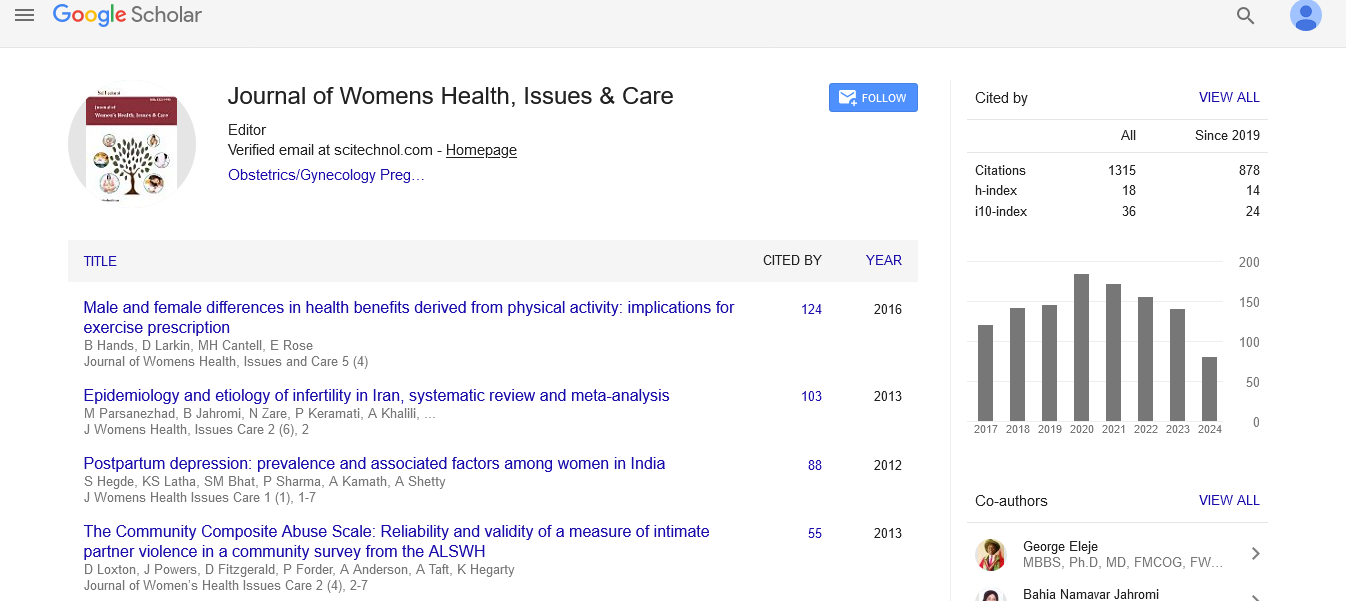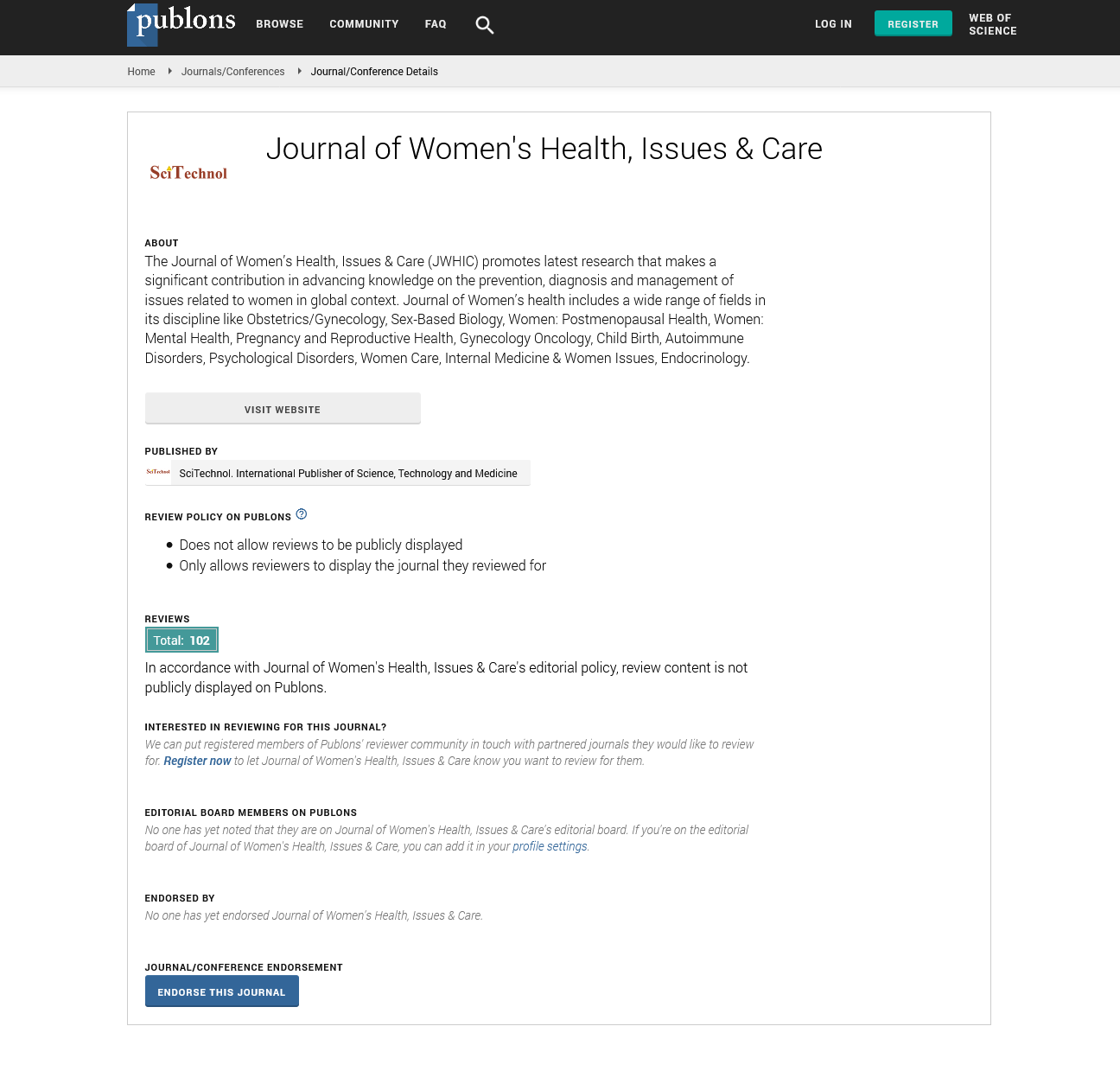Commentary, J Womens Health Vol: 13 Issue: 5
Comprehension Female Pelvic Floor Disorders: Causes, Impacts and Management
Yuisui Sajim*
1Department of Reproductive Health, University of Sydney, Sydney, Australia
*Corresponding Author: Yuisui Sajim,
Department of Reproductive Health,
University of Sydney, Sydney, Australia
E-mail: yuisui_sajim09@gmail.com
Received date: 23 September, 2024, Manuscript No. JWHIC-24-156581;
Editor assigned date: 25 September, 2024, PreQC No. JWHIC-24-156581 (PQ);
Reviewed date: 09 October, 2024, QC No. JWHIC-24-156581;
Revised date: 17 October, 2024, Manuscript No. JWHIC-24-156581 (R);
Published date: 25 October, 2024, DOI: 10.4172/2325-9795.1000520.
Citation: Sajim Y (2024) Comprehension Female Pelvic Floor Disorders: Causes, Impacts and Management. J Womens Health 13:5.
Description
Female Pelvic Floor Disorders (PFDs) encompass a group of conditions resulting from the weakening or dysfunction of the pelvic floor muscles and connective tissues. These disorders are common among women, particularly as they age and can significantly impact quality of life. The primary forms of PFDs include pelvic organ prolapse, urinary incontinence and fecal incontinence, each presenting unique challenges and requiring targeted interventions. The pelvic floor consists of muscles, ligaments and connective tissues that support the bladder, uterus, rectum and other pelvic organs. These structures maintain proper organ function and control, such as urinary and fecal continence. When the pelvic floor becomes weakened or damaged, the organs may descend, lose support, or lose function, leading to the development of PFDs.
One of the most recognized pelvic floor disorders is pelvic organ prolapse. This occurs when the pelvic organs, such as the bladder, uterus, or rectum, descend into or outside the vaginal canal. Women with pelvic organ prolapse may experience symptoms like a bulge or pressure in the vaginal area, discomfort during interaction, or difficulty with urination or bowel movements. Risk factors include childbirth, particularly vaginal deliveries, aging, obesity and connective tissue disorders. The condition can range from mild to severe, affecting daily activities and overall comfort. Urinary incontinence, the involuntary loss of urine, is another prevalent PFD. It can visible in different forms, such as stress incontinence, urge incontinence, or mixed incontinence. Stress incontinence occurs when physical activities, like coughing, sneezing, or exercising, cause urine leakage due to weakened pelvic floor muscles. Urge incontinence, on the other hand, involves a sudden and intense need to urinate, often resulting in leakage. These conditions are often linked to childbirth, hormonal changes during menopause, or increased abdominal pressure.
Fecal incontinence, or the inability to control bowel movements, is a less commonly discussed but equally impactful PFD. Women with fecal incontinence may experience involuntary stool leakage, urgency, or discomfort. This condition often arises from damage to the anal sphincter or pelvic floor muscles during childbirth, surgery, or due to aging and neurological conditions. The causes of PFDs are multifactorial and involve a combination of physical, hormonal and genetic factors. Pregnancy and childbirth, especially when associated with prolonged labor, large babies, or the use of forceps, significantly increase the risk of pelvic floor trauma. Aging and menopause also contribute due to the natural decline in estrogen levels, which weakens pelvic tissues. Additionally, obesity, chronic coughing, heavy lifting and constipation can place undue stress on the pelvic floor, exacerbating dysfunction.
The impact of PFDs extends beyond physical symptoms, affecting emotional and social well-being. Many women with these conditions experience embarrassment, low self-esteem and social withdrawal due to the unpredictable nature of symptoms. Intimacy may also be affected, leading to strained relationships and psychological distress. Managing PFDs requires a personalized approach that considers the type and severity of the disorder, as well as the patient’s overall health and lifestyle. Conservative treatments often serve as the first line of defense. Pelvic floor physical therapy, including kegel exercises, can strengthen the muscles and improve symptoms. Behavioral modifications, such as fluid management and dietary changes, may also be effective, particularly for urinary and fecal incontinence.
For moderate to severe cases, medical and surgical interventions may be necessary. Pessaries, devices inserted into the vagina to support prolapsed organs, provide a non-surgical option for pelvic organ prolapse. Medications, such as topical estrogen or anticholinergics, are commonly prescribed for urinary incontinence. Surgical procedures, including sling operations or pelvic reconstruction, may be recommended for more persistent or debilitating conditions.
Conclusion
Prevention plays a vital role in reducing the prevalence of PFDs. Encouraging pelvic floor exercises during and after pregnancy, maintaining a healthy weight and avoiding heavy lifting can moderate risks. Regular check-ups with a healthcare provider also ensure early detection and management of symptoms. Ongoing research into the causes and treatments of PFDs is vital for improving outcomes. Advances in surgical techniques, materials for pelvic support and noninvasive therapies hold promise for better management. Awareness and education are equally important, empowering women to seek help and discuss these conditions without stigma. By promoting a multidisciplinary approach to care, the burden of female pelvic floor disorders can be significantly alleviated, ensuring better quality of life for affected women.
 Spanish
Spanish  Chinese
Chinese  Russian
Russian  German
German  French
French  Japanese
Japanese  Portuguese
Portuguese  Hindi
Hindi 



